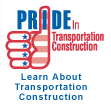





 |
 | |
    | ||
|
|||
     |
Historic Preservation
and Litigation Issues
Washington, D.C. [October 08, 2002]—Congress must address two key issues legislatively in order to cut the growing time it takes to plan and build transportation improvements, the American Road & Transportation Builders Association (ARTBA) told a congressional subcommittee today. In testimony before the House Subcommittee on Highways and Transit, ARTBA witness Brian Holmes said Congress needs to more clearly define the applicability of federal historic preservation laws in transportation planning and also set time limits for challenging transportation plans and projects in court in order to speed up project delivery. Holmes, executive director of the Maryland Highway Contractors Association, an ARTBA state affiliate, said both of these issues would be appropriately addressed by H.R. 5455, the "Expediting Project Delivery to Improve Transportation and the Environment Act" (ExPDITE). ARTBA endorsed the bill, which was introduced Sept. 25 by House Transportation & Infrastructure Committee Chairman Don Young (R-Alaska). Holmes testified on a panel that also included representatives from the American Association of State Highway & Transportation Officials (AASHTO), the American Council of Engineering Companies (ACEC), American Public Transportation Association (APTA) and the American Highway Users Alliance (AHUA). He pointed out that a Transportation Research Board study has quantified that deliberations over historic preservation issues under Section 4(f) of the Department of Transportation Act of 1966 and Section 106 of the National Historic Preservation Act are causing the greatest number of delays in the transportation project environmental review process. These sections of law, which, Holmes said, are vaguely written, are increasingly being invoked by transportation project opponents to delay the planning, design and construction processes. "We are concerned that this situation could get even worse as Interstate Highway System structures turn 50 years old, thus making them eligible for consideration of historic designation status," Holmes said. "If that were to happen, the resulting delays in improving aged structures could threaten the nation's productivity and economy." Holmes told the subcommittee ARTBA has spent over $1 million in litigation costs in recent years defending the current transportation planning and approval process in court challenges mounted by groups opposed to expansion of highway capacity. He noted that in just the past three years, litigation in which ARTBA has been involved had allowed more than $40 billion in challenged transportation projects to move forward. "The process should require that legal issues be resolved early on in the planning process, so that the courts are not used at the 11th hour simply as a delay tactic," Holmes said. The ARTBA spokesman pointed to a U.S. General Accounting Office study that found it now takes nine to 19 years to plan, gain approval of, and construct a major, federally-funded highway project. "Current law
and regulations require about 200 major steps for moving a project
forward," Holmes said. "The process involves dozens of overlapping state
and federal laws. While Holmes said new government research has also found the average environmental review process for even the small transportation projects that make up 97 percent of the nation's transportation capital investment program has more than doubled-in some cases taking up to three-and-a-half years. Major professional environmental groups also testified at the hearing. The Washington, D.C.-based ARTBA, which marks its 100th anniversary in 2002, represents the interests of the U.S. transportation construction industry exclusively before the Congress, administration, federal agencies and courts. The industry's work generates over $2 billion annually in U.S. economic activity and sustains 2.5 million American jobs. ### Editors Note: The oral presentation of Brian Holmes's testimony:
Meetings & Events | Join ARTBA | Members-Only | Foundation Programs About ARTBA | Search | Site Index | Industry Links | Home |
|||||||||||||||||